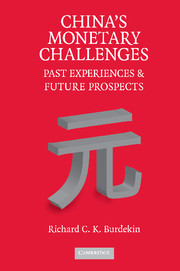Book contents
- Frontmatter
- Contents
- Preface
- Introduction: China Today and Lessons from the Past
- PART I CHINA'S EXCHANGE RATE REGIME AND MONETARY POLICY
- 1 The Renminbi–US Dollar Exchange Rate Controversy
- 2 China's Reserve Buildup and Global Imbalances
- 3 Combatting Inflation and Deflation
- 4 People's Bank of China Policymaking and External Pressures
- PART II THE IMPORTANCE OF INTERNATIONAL FACTORS, PAST AND PRESENT
- PART III THE PEOPLE'S REPUBLIC'S ROLE WITHIN GREATER CHINA AND ASIA
- 10 Conclusions and Future Prospects for the Renminbi
- References
- Author Index
- Subject Index
1 - The Renminbi–US Dollar Exchange Rate Controversy
Published online by Cambridge University Press: 06 July 2010
- Frontmatter
- Contents
- Preface
- Introduction: China Today and Lessons from the Past
- PART I CHINA'S EXCHANGE RATE REGIME AND MONETARY POLICY
- 1 The Renminbi–US Dollar Exchange Rate Controversy
- 2 China's Reserve Buildup and Global Imbalances
- 3 Combatting Inflation and Deflation
- 4 People's Bank of China Policymaking and External Pressures
- PART II THE IMPORTANCE OF INTERNATIONAL FACTORS, PAST AND PRESENT
- PART III THE PEOPLE'S REPUBLIC'S ROLE WITHIN GREATER CHINA AND ASIA
- 10 Conclusions and Future Prospects for the Renminbi
- References
- Author Index
- Subject Index
Summary
Renminbi's further appreciation is megatrend…
(Wu Xiaoling, Vice Governor of the People's Bank of China, 2005)Introduction
Mainland China's surging exports in the early twenty-first century, and growing importance in world trade, have been accompanied by unprecedented scrutiny of its exchange rate policy not only by academics but also by politicians and policymakers, especially those in the United States. The controversy initially focused on China's maintenance of a constant pegged exchange rate with the US dollar. Although US policymakers had repeatedly urged China to maintain this pegged rate during the 1997–1998 Asian financial crisis, the exchange rate parity of 8.28 RMB/$US was subsequently seen as too cheap, making China's exports cheaper in US dollar terms and accounting for China's growing trade surpluses with the United States. Since China's movement away from a pegged exchange rate in July 2005, the debate has shifted to the question of whether the currency's rate of appreciation against the US dollar is sufficiently rapid. This chapter discusses the evolution of China's exchange rate policy and offers some historical perspective on the valuation of China's currency, the renminbi (which means “people's currency,” in Chinese). Recent renminbi valuations do not seem to have been too out of line with levels recorded in the 1990s, nor has ongoing empirical analysis of the currency's purchasing power yielded any consistent support for US charges of drastic renminbi undervaluation.
However, Chinese authorities are right to be concerned about growing flows of funds into the country, and the renminbi.
- Type
- Chapter
- Information
- China's Monetary ChallengesPast Experiences and Future Prospects, pp. 11 - 32Publisher: Cambridge University PressPrint publication year: 2008



